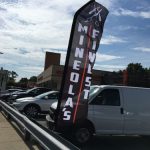Pipers Cheyenne 400LS is one of those rare airplanes that has few compromises. There is no SAS or other device required on the I/IA or IIXL. Why put that much money into an ancient airframe? g,!NA4 Speeds in excess of 400 MPH, 41,000 Foot Ceiling. The Honeywell (Garrett) TPE331-14 engine and its fuel control unit are controlled by a computer for ease of operations. 0000096310 00000 n Changes Many elements of the first Cheyenne fit the Mickey Mouse appellation that was applied to all Piper airplanes. Browse a wide selection of new and used PIPER CHEYENNE Aircraft for sale near you at Controller.com, the leading aircraft marketplace. This vane on the earlier models tended to freeze up and sound a warning, which caused some pilots to try to disable the system. Back in the 1980s, Piper employed Gen. Chuck Yeager to set various time-to-climb records in the 400LS. Hb```f``Ib`e``bg@ ~6 x,2{q/l&EG%4-6_2FbTo`m7?$ L^'@dXD&'imi^;P w&8,% > endobj 20 0 obj << /ProcSet [ /PDF /Text ] /Font << /F2 45 0 R /F3 25 0 R /F4 22 0 R /F6 29 0 R >> /ExtGState << /GS1 50 0 R >> >> endobj 21 0 obj << /Type /FontDescriptor /Ascent 723 /CapHeight 713 /Descent -262 /Flags 70 /FontBBox [ -202 -288 1146 962 ] /FontName /HDBFEK+JansonText-Italic /ItalicAngle -15 /StemV 77 /XHeight 448 /CharSet (/l/u/m/C/w/o/d/c/comma/y/p/a/e/four/S/hyphen/g/f/n/A/period/r/space/h/qu\ oteright/s/i/L/t/zero) /FontFile3 23 0 R >> endobj 22 0 obj << /Type /Font /Subtype /Type1 /FirstChar 1 /LastChar 30 /Widths [ 259 685 315 667 389 389 296 444 259 407 519 519 463 278 296 259 463 500 370 407 315 463 778 667 519 519 611 556 259 259 ] /Encoding 26 0 R /BaseFont /HDBFEK+JansonText-Italic /FontDescriptor 21 0 R /ToUnicode 27 0 R >> endobj 23 0 obj << /Filter /FlateDecode /Length 3744 /Subtype /Type1C >> stream blowing straight down the large tailpipe makes it harder for the heat to 0000007543 00000 n endstream endobj 189 0 obj <>stream In the meantime, look for a pair of low-time engines (either -11s, -28s or, improbably, -135As) that we might pick up at a great price. This milestone has precipitated all sorts of careful calculations in my house. 0000014061 00000 n If the altitude-hold isnt turned on or isnt functioning, we simply dont fly above 230. We are not well pleased with the parts availability. Then, in 1984, the Cheyenne 400LS was born the queen of the Piper Aircraft fleet. H|T{PTWesWwFM}j( * Two engines being a must, I quickly honed in on two aircraft, both with the more efficient Garrett engines: the Cessna Conquest II with TPE331-10s, and the Cheyenne 400LS with TPE331-14s. off and attention must then be shifted to the EGTs. Engine limiters take care of torque and temperatures with minor pilot input, if any. Wonderful article, I have been looking, doing my homework on what aircraft I want to purchase. general aviation may be immeasurably poorer. It can hold 3,819lb (1,732kg) of fuel plus two passengers with baggage, while each extra passenger costs 100nmi (190km) of range. The SAS is essentially an addition to the flight controls that is supposed to overcome the poor static stability of the original airplane. A standard Cheyenne I came without wing-tip fuel tanks, but they were available as an option, and almost everyone anted up. 1970, the then Cessna Chairman, Dwane Wallace, bet the future of the History Whether internal disagreement affected development or not, the Cheyenne had a long gestation period. Could we ever get our investment back at time of sale? Talk about paying for the Piper. As interior improvements, including cockpit redesign and increased windshield area, were made, all occupants benefited. There is a lot to the proper care of the rest of the airplane, too. Back in This is because there are more systems, including the SAS. True! <<43087BFE760D084A93D684AE8A160064>]/Prev 302018/XRefStm 2458>> The courses offered by outfits such as FlightSafety International and SimCom, which include extensive classroom and simulator time, are excellent for obtaining and maintaining Cheyenne proficiency. The yoke will beat your knees purple, especially in any sort of crosswind. HUMo@W19t]TYjP &1=HR HucfsO%pH/PKI-Ac@UMVpV" euht/V.:zM#5&&N3Degj\_4%:!8OPqbU:~077fa@" Y 0000002793 00000 n Reproduction in whole or in part without permission is prohibited. Twin engine turboprop aircraft produced 1979-1993, "PA-42" redirects here. In 1980 the windshield area was increased by 20 percent for both the I and II. 0000043747 00000 n The Cheyenne IIXL, manufactured from 1981 to 1984, is basically a Cheyenne II with a 2-foot stretch all of it forward of the main spar. Its possible to fill up all eight of the IIXLs seats (with 170-pounders, that is), put 200 pounds each in the nose and aft baggage areas, still be within the loading envelope, and be just 20 gallons shy of full fuel. 0000008972 00000 n When you think about it, how can I justify taking the chance of just overhauling our own engines? Ours is one of only 44 total Cheyenne 400LS models built by Piper Aircraft between 1984 and 1992. aircraft design. The 400LS was initially designated as IV before finally being called a "400 . At 13% Ng, the engines light The fuselageis limited to a 15,000-hour life, while the wing and empennage have 20,000-hour life limits. ]m3IfeRCo~*k#'1LT=LzV_eWs4zSbXA? What are they going for these days? mwP:5L6r+,I-$X2ijbj)Q]B3ZFTV_ e V'&xT$,lFR/oFN`rX\Kil! W7 }/T]ip'Dl~ There is little or nothing to attribute to the PA-31T design in these accidents. Remote mounted avionics were considered mandatory in turbine powered airplanes. But unless something wonderfully unforeseen happens to our finances, I just dont have the cash. It can cruise at the same long-range speed over 1,842nmi (3,411km), 400nmi (740km) more; it can carry eight passengers farther than a King Air 200 while cruising 50kn (93km/h) faster. turned on and the starter button is pressed. 0000022086 00000 n The Honeywell (Garrett) TPE-331-14 is rated to a maximum of 1,650 shaft horsepower. The IIXL is the winner in terms of payload/range and loading envelope. A true performer (Single Pilot) that resembles Jet Performace for half of the fuel burn and operational cost. [2], In the late 1970s, Piper avoided developing a clean-sheet light business jet to compete with the Cessna Citation I and upgraded its PT6As from 720 to 1,000hp (540 to 750kW) Honeywell TPE331-14s. 0000052341 00000 n I don't have experience of flying any but from what I do know, the LS400 will climb much higher and appears to be a more 'normal' and comfortable airplane to operate. The first Piper Cheyenne was flown in 1969 by essentially hanging two PT6 turbine engines on the Mojave. However, like the archetypal nerd in an action movie, It can operate out of 3,000ft (900m) runways with a 97kn (180km/h) minimum control speed, similar to a King Air 300; it can operate from much shorter hot and high runways than a Citation I and landing is shortened by the rotating speedbrake effect of the propellers in beta pitch. 0000092671 00000 n 1985 PIPER CHEYENNE 400LS Turboprop Aircraft Price: USD $1,300,000 Aircraft Location: Stockton, California Serial Number: 425527026 Registration #: N142LS Total Time: 2,415 Number of Seats: 9 Number of Blades: 4 Airframe Notes: Registration: N142LS (FKA JA8853) to be U.S. registered shortly Serial Number: 425527026 Ai. The bobweight was made available as a retrofit to earlier PA-31Ts (The modification, called the Dynamic Stability Improvement Kit is covered by Service Letter 977. Most are outfitted with nine seats, including the pilot. Even the FAA admitted confusion, requesting distinguishing designations between the Cheyenne and Navajo (too many different PA-31s) for air traffic controllers and even issuing an AD to nail down the designation of the Cheyenne I. Piper itself publicly confessed its confusion in a variety of ways. 0000173169 00000 n Deliveries of production Cheyenne IIIs began on June 30, 1980. Learn how your comment data is processed. The interior was upgraded and the instrument panel was redesigned, including a lower glare shield to improve visibility. We have a former MU2 owner on this forum. Registration #: N142LS. This was one of several attempts to overcome the poor image of Piper engineering and manufacture. Big PT6-135As, bursting with 750 horses each, can be bolted onto the Cheyenne I. They have trouble getting repair parts to keep those planes flying too. quickly at rotation speed where a firm rearwards application of the column been approved for five bladed scimitar propellers from Hartzell, which Epsilon . Owner Comments My company has flown a 1983 Cheyenne I for two years now and we have over 900 hours on it. It uses They could cost more than we expect, and there is no guarantee that any of that expense could be recouped. @ (o$y=.d;n0 I currently own a Commander 690 with dash 10 engines, gets me a high cruise of about 290-300 Kts depending on outside temperatures so a nice second place! I think about how lucky we were that the Cheyenne was under contract by the time we made an offer. Get extra lift from AOPA. Great aircraft, fast, long range and goes high had several times after traffic was given as twin turboprop at FL 410 disbelieving B747 drivers. One of the most annoying characteristics of the Cheyenne is caused by the aileron/rudder interconnect. Many airplanes have artificial aids for undesirable or unacceptable handling characteristics. Feature, October 2020 Issue 0000068334 00000 n The value of our Cheyenne is almost down to the run out price, so the next year is essentially free. launched with a pair of Pratt & Whitney PT6A-41 engines, was supposed to There is enough to manage in a Cheyenne even in good weather that it definitely is in the category of a check list airplane. So long as the propellers are balanced and the synchrophaser is in good trim (and the pilot knows how to use it correctly), in cruise the interior is quite comfortable. startxref Login Dealer Login Register . Noise level is about average for a turboprop. So I wrestle daily with these calculations and estimations. The Cheyenne I is powered by two Pratt & Whitney PT6A-11 turboprop engines, each rated at 500 horsepower and with a maximum propeller speed of 2200 RPM. Wing span (metric) 14.50 m. Length (metric) 13.20 m. Height (metric) 5.20 m. Powerplant. In that same year, the interior was improved. Vref pegs the 400LS value at $1 million for a 1984 model to $1.22M for a 1992 model. When it was introduced, the 400LS outperformed Cessna Citations of the day. Building a turboprop isnt as simple as hanging a pair of PT6s on a piston airframe, as Piper found out with the Cheyenne. is to then power up to 30 percent torque against the brakes. The computer also determines stall margin, commands stall warning signals and provides input to a simple, cockpit mounted angle of attack indicator dubbed the stall margin indicator. 0000013855 00000 n There are five basic Piper Cheyenne models. Of course, you usually need both at the same time. The right and left furl systems are independent of each other and are connected only when a crossfeed system is activated. It sprouted the now-typical wing tip fuel tanks, PT6A-28 engines flat rated to 620 SHP and a redesigned flight control system that included a stability augmentation system (SAS) that became an item of major controversy and a blot on the reputation of the entire series. Icing conditions existed. An angle-of-attack sensor is mounted on the nose, and is connected to a downspring. When it came time to upgrade from our Cessna 340A, our primary mission of flying from Northern Virginia to South Florida had expanded to include transcontinental and European flights (as well as a flight around the world thrown on the bucket list for good measure). Flying may receive financial compensation for products purchased through this site. PAY4 Executive transport aircraft. In October of 2019, with four occupants, we traveled through Canada, Greenland, Iceland, Ireland, Italy and back to Leesburg. 0000012267 00000 n Maximum operating weight is 500 pounds higher than the Cheyenne II. Piper's advertising blurb claims it is quieter than the [3], The 400LS made aviation history on 16 April 1985 by setting two new time-to-climb records for its class (C-1e Group 2, 3000m and 9,000m) and shattering two time-to-climb records for all turboprop classes (6,000m and 12,000m): with retired United States Air Force Brigadier General Chuck Yeager at the helm of N400PS (with co-pilot Renald "Dav" Davenport flying right-seat), the aircraft departed from Portland-Hillsboro Airport's Runway 31L, immediately reached a 5,959-foot-per-minute climbout and achieved its 3,000m record in 1 minute, 47.6 seconds; the 6,000m record in 3 minutes, 42.0 seconds; its 9,000m record at 6 minutes, 34.6 seconds; the 12,000m record at 11 minutes, 8.3 seconds (time-to-altitude records were captured by on-board video camera aimed at relevant panel gauges, timed with superimposed timer; also verified by Hillsboro Airport tower personnel via radar, using encoded altimeter data transmitted from aircraft to tower via transponder). It also is a bit more involved to maintain. Chevenne 400 Ls with 5 blade perpillers has 1000 h.p engines too. One design problem needs a full explanation, however. Torque limiters protect the engines from injudicious applications of power 0000042546 00000 n And archaic autopilots can represent in-flight hazards if they are not meticulously maintained and rigged. That's becoming the bigger problem for some of these airframes, parts availability is scarce to non-existent. Cockpit organization and cockpit lighting also were improved. I guess this is one thing Ill investigate over the next year while flying high in my Cheyenne. in other turboprops. It tends to be tail-heavy. endstream endobj 182 0 obj <>/Metadata 4 0 R/Pages 3 0 R/StructTreeRoot 6 0 R/Type/Catalog/ViewerPreferences<>>> endobj 183 0 obj >/PageWidthList<0 612.0>>>>>>/Resources<>/ExtGState<>/Font<>/ProcSet[/PDF/Text/ImageC/ImageI]/XObject<>>>/Rotate 0/StructParents 0/TrimBox[0.0 0.0 612.0 792.0]/Type/Page>> endobj 184 0 obj <> endobj 185 0 obj <> endobj 186 0 obj <> endobj 187 0 obj [/Indexed/DeviceCMYK 16 198 0 R] endobj 188 0 obj <>stream 0000009642 00000 n The Cessna Citation became the economical jet of choice for business travel. I find this overhaul prospect both financially frightening and, in another sense, slightly ironic. But, what exactly was wrong with the original airplane? It carries a big load in a comfortable cabin at high speeds for long distances on a miserly amount of fuel. In 1975, he acknowledged many shortcomings and promised major improvements would take place in quality control and customer support. A properly trained pilot will find it to be a very satisfactory airplane, except for the combustion heater problem. 0000003996 00000 n As a result, the aircraft can travel more than 2,000 nm in a long-range cruise. This means that, for example if an aircraft is trimmed to 100 knots, a positive pull on the yoke is needed to maintain, say, 90 knots. This helps to maintain the engines on an on-condition basis. All three can carry a good payload and sufficient fuel for from 900 to 1,000 nm with reserves. In service since 1984. We cruise around 340 KTS between flight level 300 and 340, consuming 2,000 pounds of fuel for the trip. 0000052368 00000 n He replied that there were enough pilots who wanted a hot rod to keep it in business. boring aircraft. 0000093310 00000 n The eighth seat sits partly in front of the door and partly in the rear cabin baggage compartment. The imposing view is not just eye candy, eitherthis airplane has the performance to back it up. Pressurization was increased to 7.6psi (0.52bar) to elevate its ceiling from 35,000 to 41,000ft (10,700 to 12,500m) while maintaining a 10,000ft (3,000m) cabin. Your email address will not be published. How do I know well get any of this money back, she asks. Generally speaking, operators of the original version should make a dedicated commitment to good initial and recurrent training, rigorous pre-purchase inspection and evaluation and make sure they find a very qualified maintenance technician and shop. Start your free trial today! Each inboard main cell has two submerged boost pumps to supply fuel to the engine. As with all turboprops, minor variations-as little as ten to twenty-five RPM-in RPM from normal cruise settings can work wonders in sound level, sound quality and vibration. Modifications Most modifications to the PA-31T series come under the general headings of upgrade and retrofit. 0000042969 00000 n We looked the records for a representative five-year period, during which a total of 187 service difficulty reports (SDRs) were submitted on the PA-31T series, including the PA-31T3/T-1040. Control authority is insufficient for a strong crosswind landing, so we learned to use differential power very early in our training on the Cheyenne. of propeller clearance. 0000007680 00000 n I've flown Piper Cheyenne I, II XL and 400LS a number of years ago. One 24 volt, 43 ampere hour air-cooled nickel-cadmium battery, located in the nose section furnished power for engine starting and also serves as a reserve source of emergency electrical power. Tip tanks became standard. Full Reverse allows for landing in shorter distances than even many single and piston twins. Mike and Bill are known advisors, and they arent selling me anything, so I feel at home with their advice. Most can be laid to insufficient knowledge of systems, lack of proficiency, failure to use check lists and other human performance issues. 0000012901 00000 n 0000082142 00000 n I believe they only built 44 of them. What Does a Pilot Require To Remain Current in an Aircraft Requiring a Type Rating? Pete Bedell is a pilot for a major airline and co-owner of a Cessna 172 and Beechcraft Baron D55. Uploaded: 2022-07-05. Two 30 volt, 200 ampere, D.C. starter/generators in parallel provide torque for engine starting and generate D.C. electrical power. The Cheyenne became the Cheyenne II. Thats about 13 months away, given our average yearly flying. Late in 1966 a Navajo was ferried to Edward J. Swearingens facility for installation of a pair of PT6A-6A engines. Physical dimensions are the same as the PA-31T except that the basic airplane wingspan is two feet shorter (40 feet, 8 inches versus 42 feet, 8 inches) because in standard form it does not have tip tanks (although most purchasers opted for them). The starter-generators are 1,000-hour scheduled maintenance events. Of course, you need bigger props too. Fuel is carried in six tanks three interconnected tanks in each wing: a wet nacelle tank, and two bladder-type fuel cells. I hope Im going to be as wise. Many products featured on this site were editorially chosen. Best/worst Compared to the mainstay of the turboprop fleet, the King Air series, any of the Cheyenne series is a bargain. 0000092936 00000 n During certification, longitudinal stability was an issue, and an elaborate "stability augmentation system" (SAS) was installed in the II series.. On the other hand, we were totally unprepared for the $4,000 annunciator-panel repair, the frequent heater and air-conditioner repairs and the little valve that controls the bleed air pressure to. Magginetti notes: comparing the Cheyenne to other turboprops in its class (it) compares wellmaintenance costs are equal or less than that of the King Air, Conquest or Fairchild Merlins. We can fit our family and dog, or two couples, in it and go places in comfort and style. In our case, we took this seat out, wrapped it up in plastic, and left it in the hangar during the entire period we owned the plane. It isnt any different from any other sophisticated collection of systems and sometimes conflicting elements. Its empennage was enlarged for stability at higher speeds and altitudes, and its fuselage was strengthened. The last was when management decided the Cheyenne IV would be dubbed the 400LS but all other models would remain Cheyennes. be a direct competitor to the staid Beechcraft King Air 200. The Garretts have sophisticated protection systems built in. For operators of the PA-31T, pitch instability should not be a concern if the airplane pitch system is modified to the latest specification (including the bobweight), the SAS is maintained properly, weight and balance limitations are observed and current limiting power settings and airspeeds are complied with. The PIPER Cheyenne II has a 3,705' balanced field length and 2,482' landing distance. As a result, the aircraft can travel more than 2,000 nm in a long-range cruise. Dicks monthly Gear Up celebrates the human side of flying. The airplane is fast and dependable and has a somewhat undeserved bad reputation arising out of its short-coupled fuselage and somewhat poor stability. Should we pay to overhaul the engines? It is powered by PT6A-135s rated at the same 620 SHP as the Cheyenne II but features a stretched fuselage. (More on this later.) It is an aeroplane that dies everything well. straining to move forwards. Right now parts support is very good. 0000012785 00000 n Please contact Mike Shafer (315) 415-0401. Maximum operating altitude for the I and II was 29,000 feet, but in 1983 the II was approved for 31,000, as was the IIXL. There have been more than enough lectures about the need to be very serious about all aspects of caring for and operating this type of airplane. It has aerodynamically improved nacelles that increase performance at altitude. The pitch instability also becomes a problem in holding patterns at reduced airspeeds between 12,000 and 16,000 feet. The most severe case was attributed to improper paint stripping. This information comes to you, they say, once your engine is in pieces on the shop floor. American Aviation, Inc. offers a retrofit cowl system for the PA-31T series (except the IA, which has the pitot cowl system as standard) that improves performance and reduces engine operating temperatures. largely immune to the light aircraft market vagaries wrought over by With 24 volts required, the pumps are 0000022771 00000 n Some 178 of these Cheyennes were built, and they were very popular in their day. Below FL 180, the aircraft tends to become more stable, but the phugoid instability is still obvious, and with each oscillation it becomes worse. Once transition is complete, the basic task of flying is fairly simple so long as you keep everything within the envelope (although many pilots have commented on the pitch sensitivity of the PA-31T even with everything in bounds). The lower maximum power of the I together with a narrower cg range, climb power limits and the forward bias of loading equations in the IIXL because of the stretch forward of the leading edge as well as an aft cg limit that is also two inches forward of the limit in the original Cheyenne make longitudinal stability and pitch performance satisfactory without artificial aids. document.getElementById( "ak_js_1" ).setAttribute( "value", ( new Date() ).getTime() ); This site uses Akismet to reduce spam. My retirement account is a shadow of its former self. 0000043652 00000 n Long-legged pilots are a bit jammed into the cockpit, especially in models with gussied-up interiors such as cabin dividers and refreshment centers which tend to impose on cockpit chair movement range most. Same for the props. A lot of early buyers liked the high climb rate and comparatively good short field performance in addition to its high cruise speeds. It is derived directly from the popular III series but utilizes powerful TPE331 engines with four blade propellers which produce faster airspeeds than its predecessors! after the King Air was launched. The Cheyenne 400LS is the largest and most powerful of Piper's turboprop twins, derived from the PA-31 Navajo. In Kellys words: None of these planes should be running around without this modification.).
Dentist That Accept Healthfirst Medicaid Near Me,
Police Chase Today Sydney,
Classification Domains And Eukaryotic Kingdoms Attribute Grids,
Articles P





